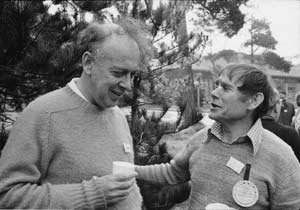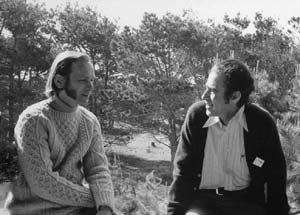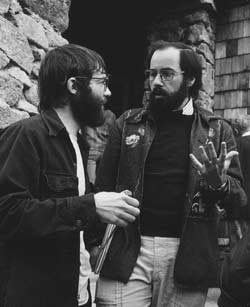Paul Berg
Article

Asilomar and recombinant DNA
by Paul Berg
1980 Nobel Prize laureate in chemistry
26 August 2004
Introduction
Advances in the life sciences, particularly in biomedicine, are increasingly being scrutinized and their acceptance questioned. Novel technologies and ideas that impinge on human biology and their perceived impact on human values have renewed strains in the relationship between science and society. Thirty years ago, nations were engaged in debates about whether recombinant DNA research, also referred to as gene splicing and genetic engineering, was too dangerous to be allowed to continue. Fears of creating new kinds of plagues or of altering human evolution or of irreversibly altering the environment were only some of the concerns that were rampant. Lingering doubts and concerns still persist about the use of that technology in the development of genetically modified plants and animals used as food. Notably, some nations have enacted legislation that prohibits genetically-modified plants and animals from entering into their food supply. Paradoxically, no such embargo exists for the drugs and therapies that have revolutionized the treatment of serious diseases although many of them were created with the same technologies.
Today, it is research with human embryonic stem cells and attempts to prepare cloned stem cells for research and medical therapies that are being disavowed as being ethically unacceptable. As with the GM food controversy and other cases where science and public policy clash, there are repeated calls to convene an “Asilomar Conference” to examine and resolve the policy controversies.
Unique conference
The lofty status of the Asilomar Conference and the deliberative process it spawned stems from its success in identifying, evaluating and ultimately mitigating the perceived risks of recombinant DNA. Looking back now, this unique conference marked the beginning of an exceptional era for science and for the public discussion of science policy. Its success permitted the then contentious technology of recombinant DNA to emerge and flourish. Now the use of the recombinant DNA technology dominates research in biology. It has altered both the way questions are formulated and the way solutions are sought. The isolation of genes from any organism on our planet, alive or dead, is now routine. Furthermore, the construction of new variants of genes, chromosomes and viruses is standard practice in research laboratories as is the introduction of genes into microbes, plants and experimental animals. Without the tools of recombinant DNA there would be no human or any other genome sequence. Equally profound is the influence it has had in many related fields. Even a brief look at journals in such diverse fields as chemistry, evolutionary biology, paleontology, anthropology, linguistics, psychology, medicine, plant science, and, surprisingly, forensics, information theory and computer science shows the pervasive influence of this new paradigm.
Additional testimony to the conference’s success are the frequent calls to resurrect the “Asilomar Process” to resolve the ethical dilemmas posed by newly emerging ideas and technologies, most recently human embryonic stem cell research. Whether the Asilomar Conference model can duplicate its achievement for current conflicts is problematic. But in acknowledging its thirtieth anniversary, it is worth examining the circumstances that gave birth to the conference and how the outcome permitted the then contentious recombinant DNA technology to emerge and flourish.
Time and faulty memory have obscured some of the circumstances and events that led to the scientific breakthrough and the path to Asilomar. The emergence of a new paradigm in any field of science generates, along with the excitement of a new frontier and perspective, an uncertainty about its full implications. This was especially true for the geneticists that fueled the emergence of the recombinant DNA technology during the 1970s.

(Left to right) Maxine Singer, Norton Zinder, Sydney Brenner, and Paul Berg were among the participants at the Asilomar Conference.
Copyright © National Academy of Sciences
Voluntary moratorium
The concerns about recombinant DNA had their antecedent in the creation of a DNA molecule containing the entire Simian Virus 40 genome joined to a segment of DNA containing three genes responsible for galactose metabolism in Escherichia coli.1 But improvements in the technology, most notably the ability to clone DNA segments from virtually any organism on our planet,2 triggered a new level of concern which culminated in mid-1974 with a call for a voluntary moratorium on certain recombinant DNA experiments.3 This unprecedented action by a group of American scientists echoed reservations expressed at a conference on nucleic acids during the previous summer.4 Both groups acknowledged that the new technology created extraordinary novel avenues for genetics and could ultimately provide exceptional opportunities for medicine, agriculture and industry. Nevertheless, there were concerns that unfettered pursuit of this research might engender unforeseen and damaging consequences for human health and the Earth’s ecosystems. In spite of widespread consternation among many scientists about the proscriptions, the validity of the concerns, and the manner in which they were announced, the moratorium was universally observed. One goal of the moratorium was to provide time for a conference that would evaluate the state of the new technology and the risks, if any, associated with it.
That conference, held at the Asilomar Conference Center on California’s Monterey peninsula in the USA, included scientists from throughout the world, lawyers, members of the press and government officials.5,6 One aim of the meeting was to consider whether to lift the voluntary moratorium and, if so, under what conditions the research could proceed safely. Although there were few data on which to base a scientifically defensible judgment the conference concluded, not without outspoken opposition from some of its more notable participants, that recombinant DNA research should proceed but under strict guidelines.7 Such guidelines were subsequently promulgated by the National Institutes of Health8 and by comparable bodies in other countries.9,10
The primary motivation for the prompt actions taken by scientists and governments in the period 1973-1976 was to protect laboratory personnel, the general public, and the environment from any hazards that might be directly generated by the experiments. In particular, there were speculations that normally innocuous microbes could be changed into human pathogens by introducing genes that rendered them resistant to then available antibiotics, or enabled them to produce dangerous toxins, or transformed them into cancer causing agents. The uncertainties stimulated occasionally turbulent debates. Public fear was fanned by the popularity of visions of “The Andromeda Strain” and the myriad of ‘what ifs’ floated by both serious and demagogic commentators. Some scientists, and public officials as well, were certain that recombinant DNA research was flirting with disaster and that lifting the moratorium was a blunder. Others, reflecting their intuition and expertise, argued that such cells, viruses and recombinant DNAs posed no risk at all. The overwhelming assessment today is that the latter view was correct. Literally hundreds of millions of experiments, many inconceivable in 1975, have been carried out in the last 30 years without incident. No documented hazard to public health has been attributable to the applications of recombinant DNA technology. Moreover, the concern of some that moving DNA among species would breach customary breeding barriers and have profound effects on natural evolutionary processes has substantially disappeared as the science revealed that such exchanges occur in nature.

(Left to right) James Watson and Sydney Brenner confer with each other.
Copyright © National Academy of Sciences
Recombinant DNA technology
At the time of Asilomar, scientists optimistically predicted that the recombinant DNA methods would soon yield important drugs, industrial products and improved agricultural varieties. In fact, such developments took longer than anticipated. Some have never been realized because learning how to manipulate genes for useful purposes presented unexpected difficulties. Since the mid-1980s, however, the number of products has increased continually. Hormones, vaccines, therapeutic agents and diagnostic tools are enhancing medical practice. The production and consumption of genetically engineered food plants are realities although their dissemination has been limited. A thriving biotechnology industry has created products, interesting jobs and wealth for scientists and others. In retrospect, very few of those attending the Asilomar Conference foresaw the pervasive, complex, robust, and rich ramifications of recombinant DNA technology. Nor could most have predicted the pace at which fundamental understanding of biology has deepened.
Frequently heard in the 1970s were criticisms of scientists for assuming leadership in formulating policies that were matters of public concern. This led some scientists to believe that the public debate itself was a great threat and that the fallout of claim and counterclaim would bring debilitating restrictions or even prohibitions on molecular biological research. In truth, many scientists grew impatient with the time-consuming, contentious debates. Yet the effort to inform the public also encouraged responsible public discussion that succeeded in developing a consensus for the measured approach that many scientists supported. Restrictive national legislation was avoided, and in the long run, scientists benefited from their forthrightness and prudent actions in the face of uncertainty.
Ethical and legal implications
An often-voiced criticism of the Asilomar Conference discussions was the failure to consider the ethical and legal implications of genetic engineering of plants, animals and humans. Did the organizers and participants of the Asilomar conference deliberately limit the scope of the concerns? The participants were scored for ignoring the increased perils of biological warfare made possible by the development of the new recombinant technology. Others have been critical of the conference because it did not confront the potential misuse of the recombinant DNA technology or the ethical dilemmas that would arise from applying the technology to genetic screening and somatic and germ line gene therapy, or the environmental consequences arising from the creation of genetically modified food plants.10 It should not be forgotten that these possibilities were still far in the future and the more immediate issue confronting the Asilomar organizers and participants was the one the scientists had raised: the potential risks to human health and the environment posed by the expanding recombinant DNA technology. We could not avoid the question of whether there were serious health hazards associated with going forward with the experiments that were being planned. In short, the agenda for the three-day meeting had to focus on an assessment of the risks and how to eliminate or reduce the risks that seemed plausible. We accepted that the other issues would be dealt with as they became imminent and estimable.

(Left to right) Michael Bishop and Norton Zinder exchange views.
Copyright © National Academy of Sciences
Public trust
What did the actions taken by the scientific community achieve? First and foremost, we gained the public’s trust, for it was the very scientists who were most involved in the work and had every incentive to be left free to pursue their dream that called attention to the risks inherent in the experiments they were doing. Aside from unprecedented nature of that action, the scientists’ call for a temporary halt to the experiments that most concerned them and the assumption of responsibility for assessing and dealing with those risks was widely acclaimed as laudable ethical behavior. If the Asilomar exercise was a success, it was because scientists took the initiative in raising the issue rather than having it raised against them; that initiative engendered considerable credibility instead of cynical suspicion of what was to follow. The public’s trust was undeniably increased by the fact that more than 10% of the participants were from the news media. They were free to describe, comment on and criticize the discussions and conclusions at the end of the conference. All the deliberations, bickering, bitter accusations, wavering views and the arrival at a consensus were widely chronicled by the reporters that attended and subsequently by the rest of the media and subsequent commentators.5,9,10
Moving science forward
Is “the Asilomar model” appropriate for resolving or contributing to some of the “hot button” issues confronting scientists and the public today? For example, are the deep divisions about fetal tissue and embryonic stem cell research, somatic and germ-line gene therapy and directed genetic modification of food crops amenable to deliberation and resolution? I believe the Asilomar model would not succeed in dealing with those issues today to the extent it did 30 years ago with recombinant DNA for the following reasons. First, the public’s awareness of the recombinant DNA breakthrough was sudden and unanticipated. It was more than just another interesting scientific advance because it brought with it potential dangers to public health. Furthermore, the implications of risk came from the scientists conducting that research, not from some investigative reporter or disaffected scientist; that was most unusual, even historic. There seemed to be an urgent need for consensus on how to proceed and a plausible plan on how to deal with issues, both of which were provided by the scientific community. Action was prompt and seen by the public to have been achieved by transparent deliberations and with considerable cost to their own scientific interests. The issue and its resolution were complete before an entrenched, intransigent and chronic opposition developed. Attempts to prohibit the research or reverse the actions recommended by the conference threatened but never generated sufficient traction to succeed.
By contrast, the issues that challenge us today are qualitatively different. They are often beset with economic self-interest and increasingly by nearly irreconcilable ethical and religious conflicts and challenges to deeply held social values. An Asilomar type conference trying to contend with such contentious views is, I believe, doomed to acrimony and policy stagnation, neither of which advances the cause of finding a solution. There are many forums for airing opposing views but emerging with an agreed upon solution from such an exercise is elusive and discouraging.
The Asilomar decisions emerged from a consensus of opposing views. Although the recommendations were clearly “inconvenient”, the participants had a stake in having the science move forward and not in leaving the rules for conducting the research to be set by others. By contrast, there is little prospect for consensus in our society on the ethical issues concerning fetal tissue and embryonic stem cell research, genetic testing, somatic and germ-line gene therapy, and engineered plant and animal species and hence little incentive to seek a compromise. Compromise in those instances may only be achievable by political means, where majority rule prevails.

(Left to right) Joseph Sambrook and David Baltimore caught up in a discussion.
Copyright © National Academy of Sciences
Bibliography
1. Jackson, D.A., Symons, R.H. and Berg, P., “Biochemical method for inserting new genetic information into DNA of Simian Virus 40: circular SV40 DNA containing lambda phage genes and the galactose operon of Escherichia coli,” Proc. Nat. Acad. Sci. USA 69, pp. 2904-2909 (1972).
2. Mertz, J.E. and Davis, R.W., “Cleavage of DNA by R1 restriction endonuclease generates cohesive ends,” Proc. Nat. Acad. Sci. USA 69, pp. 3370-3374 (1972).
3. Berg, P., Baltimore, D., Boyer, H.W., Cohen, S.N., Davis, R.W., Hogness, D.S., Nathans, D., Roblin, R., Watson, J.D., Weissman, S. and Zinder, N.D., “Biohazards of Recombinant DNA,” Science 185, p. 3034, also Science 185, p. 303 (1974).
4. Singer, M.F. and Soll, D., “Guidelines for hybrid DNA molecules,” Science 181, p. 1114 (1973).
5. Rogers, M., “Biohazard,” Alfred A. Knopf, New York (1977).
6. Fredrickson, D.S., “Asilomar and recombinant DNA: the end of the beginning” in Biomedical Politics, National Academy Press, Washington, D.C., pp. 258-292 (1991).
7. Berg, P., Baltimore, D., Brenner, S., Roblin, R.O. III, Singer, M.F., “Summary statement of the Asilomar Conference on recombinant DNA molecules,” Proc. Nat. Acad. Sci. USA 72, pp. 1981-1984 (1975), also Science 188, p. 991 (1975).
8. “Guidelines for research involving recombinant DNA molecules,” Federal Register 41, no. 131, pp. 27911-27943 (1976).
9. Fredrickson, D.S., Chapters 1 and 5 in “The recombinant DNA controversy. A memoir,” ASM Press, Washington, D.C., p. 388 (2001).
10. Wright, S., “Molecular Politics: Developing American and British regulatory policy for genetic engineering,” U. Chicago Press, p. 592 (1994).
Nobel Prizes and laureates
Six prizes were awarded for achievements that have conferred the greatest benefit to humankind. The 12 laureates' work and discoveries range from proteins' structures and machine learning to fighting for a world free of nuclear weapons.
See them all presented here.
